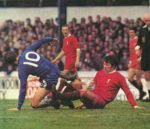Two goals from Mario Gomez saw the Germans beat their arch-rivals, Netherlands 2-1 to ensure progress to the next round of Euro 2012 (Mathematically they can still be knocked out). The difference between the two sides was clearly felt in the middle of the pitch. Although both sides on paper lined up in a 4-2-3-1 formation, the German double pivot of Khedira and Schweinsteiger were given freedom to go forward where as Nigel De Jong and Mark Van Bommel stayed behind, guarding the Dutch defence.
How the goals were scored against the Dutch
Both the goals against the Netherlands came in similar fashion. As usual, Mesut Ozil drifted out wide (His understanding with Muller is exemplary) and Nigel de Jong was forced to move out of his position to track the German’s run. This left Mark van Bommel isolated. Usually in a 4-2-3-1 Vs 4-2-3-1, van Bommel would have been expected to mark the player who is given more licence to go forward from the opposing double pivot, which generally is Sami Khedira rather than Bastian Schweinsteiger. But the key move here was made by Khedira when he made a run across to overload the right. Hence Mark Van Bommel was forced to move right as well, as there were now three German players in that territory facing only De Jong and Willems. This allowed Schweinstieger the space to move forward and pick out Gomez.
Thomas Muller may not be everyone’s favorite player, but he plays a key role in this German team. He was the one who saw Schweinsteiger free and played the ball to him, and also made a run across the pitch distracting the defenders. The second goal also arrived in similar fashion, this time it was Ozil who passed it to Schweinstieger and who again picked out Gomez with ease. The freedom with which the Double Pivot played was probably due to the lack of attacking threat from their Dutch counterparts. De Jong and Van Bommel aren’t the most technically gifted footballers, so the possibility of a counter with Sneijder staying high up the pitch was moot. The German right back Boateng also generally stayed back to provide cover, this is where the Dutch had a opportunity to reorganise. Either Sneijder should have been marking Khedira and Schweinsteiger, or Afellay could have picked Ozil, who always has this tendency to drift wide out to the right to combine with Thomas Muller.
This clearly shows that in a fluid team (Especially a fluid midfield) where every player understands and is able to predict their teammates’s movement can easily outclass a disjointed team. Joachim Loew was certainly very brave in leaving Wesley Sneijder unmarked for most of the game, and it proved to be the right decision. Ozil and Sneijder both probably are the best players on the pitch last night, but both play completely different roles. Ozil moves on to the right to allow his other midfield partners to take over where as Sneijder cant afford to do the same.
It remains to be seen how the Loew intends to play in the latter stages of the tournament, whether he allows all the three of his midfielders the same freedom he has willingly given so far. In the 2010 FIFA World Cup quarter finals against Argentina, both Khedira and Schweinsteiger were relatively playing deep and the Bayern Munich man kept Messi out of the game. In this game the main threat was the triangle formed by Muller-Ozil-Lahm, with Di Maria not very good at tracking back, the Argentine left-back Gabriel Heinze was exposed. So, against sides which offer more threat from their midfielders, the German midfield can adjust accordingly.











Recent Comments